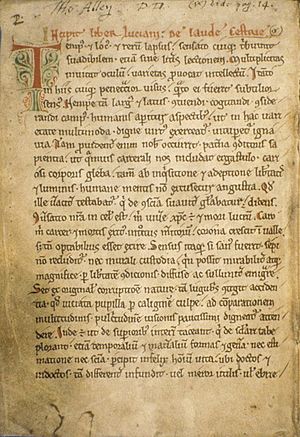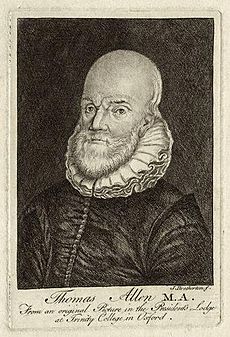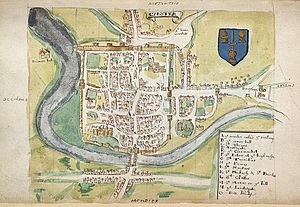De laude Cestrie facts for kids
De laude Cestrie (which means "On the Glory of Chester" in Latin) is a special book from the Middle Ages. It was written in Latin by a person named Lucian of Chester. He was probably a monk at the Abbey of St Werburgh in Chester, which is now Chester Cathedral.
This book was likely written around the late 1100s. People say it's "the oldest piece of writing from Cheshire" that we still have. It's also one of the first books to describe an English town in detail. Lucian's book is famous for explaining Chester's unique "county palatine" status. This meant Chester was almost like its own small kingdom, where the local leader (the Earl) had more power than the King of England! The original book is kept safe at the Bodleian Library in Oxford.
The Old Book Itself
We only have one copy of De laude Cestrie. It's called MS Bodley 672 and is stored at the Bodleian Library in Oxford. Many believe this is the very first copy Lucian wrote.
The book was given to the Bodleian Library in 1601 by a man named Thomas Allen. We don't know much about how he got it. But it might have stayed at St Werburgh's Abbey until the abbey was closed down in the 1500s.
The book is still in its original cover. It has 198 pages made of parchment, which is a type of animal skin used for writing. Each page is about 15 cm by 11 cm. Experts think it was written between 1194 and 1200. It's a long book, with over 82,000 words. The first page has a fancy letter decorated in red and blue. There are also notes written in the margins, possibly by Lucian or another monk.
Who Wrote It and Why?
We don't know much about Lucian, the author, apart from what's in his book. Most people think he was a monk at St Werburgh's Abbey in Chester. He wrote that he wasn't born in Chester but went to school at St John the Baptist's Church there.
Lucian said he was inspired to write De laude Cestrie by one of the church leaders at St John's. He wrote the book for both people living in Chester and for visitors. He even suggested that readers should study "the text with one eye and the streets with the other." This means he wanted it to be like a guidebook! However, since it was written in Latin, it was mainly for educated people, like other church members.
What's Inside the Book?
De laude Cestrie gives us a firsthand look at the town of Chester and its surrounding area in the late 1100s. At that time, Ranulf de Blondeville was the Earl of Chester. This book is one of the oldest descriptions of an English town that we still have.
Lucian wrote that the people of Chester were similar to the Welsh. He also gave the first detailed description of Chester's special administrative position. This was called the "county palatine." It meant that the Earl of Chester had powers similar to the King of England in this area. Lucian wrote:
The area of Chester is special and free from other English places. Because of kings' kindness and the earls' importance, it pays more attention to its prince's sword than to the king's crown. Within their area, they handle important matters very freely.
A note in the margin even added, "the earl is obeyed, the king is not feared."
Lucian described Chester's walls with their four gates, the two main streets that crossed, and the central market. He often wrote as if he was looking down on the town from above. The book tells us about international trade. Ships brought wine and other goods from places like France, Ireland, Germany, and Spain. Goods also came by land, such as grain from England, fish from Ireland, and cattle from Wales. Lucian even compared Chester to famous cities like Rome and Jerusalem.
Outside Chester's walls, he described three roads leading to nearby places like Christleton and Aldford. He also mentioned a special safe place for criminals called Hoole Heath.
Unlike other books that focused on everyday life, De laude Cestrie mostly talks about the religious side of Chester. Lucian saw the city's streets and buildings as having a deeper, religious meaning. He sometimes changed Chester's geography a little to fit his ideas.
More than half of the book talks about the monks, nuns, and clerks in the town. It especially focuses on the monastery of St Werburgh, a nunnery for St Mary, and three churches: St John the Baptist's, St Peter's, and St Michael's. Lucian said St Werburgh's name meant "the one defending the city." He even wrote about a fire in 1180, saying it was put out when St Werburgh's shrine was carried through the streets.
Lucian also mentioned four Cistercian monasteries outside the town: Combermere, Pulton, Stanlaw, and Basingwerk in Wales. He drew a diagram showing how these four monasteries formed a cross shape, with Chester in the middle. The book then describes how churches and monasteries were organized, explaining the roles of the abbot and prior. It ends by talking about the afterlife and the Day of Judgment.
See also




